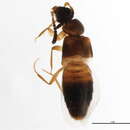en
names in breadcrumbs


See Kistner (2003) and Pace (2009) for references and keys to species.
Type species.
Myrmedonota cingulata Cameron, 1920, by monotypy (pp. 272-273).
Diagnosis.
Members of the genus Myrmedonota may be separated from other genera of Lomechusini by the following combination of characters (partially adopted from Maruyama et al. 2008 ): 1) head dorsally subcircular, excluding mouth parts; 2) head lacking neck; 3) occipital suture complete; 4) antennae generalized, clavate and slightly laterally compressed; 5) pronotum with complete marginal line; 6) pronotum without depressions or macrosculpture; 7) body surface finely punctate; 8) abdomen with no horn-like ornamentation; 9) dorsal abdominal surface with sparse to moderate setation but never with dense setal cover, nor with thick macrosetae creating a bristle-like texture; 10) cardo partially overlapping stipes, ventrally; 11) lacinia and galea extremely elongate and parallel sided; 12) labial palpomeres I and III subequal in length and longer then palpomere II; 13) glossa bifid with each lobe housing two sensillate elements; 14) mentum trapeziform and almost as long as wide; 15) labrum with lateral apices rounded and extending apically beyond maximum midpoint; 16) apical lobe of paramere short; 17) vellum and velar sac of paramere large and extending past the maximum reach of apical lobe and partially concealing it.
In North America Myrmedonota most closely resembles the genus Pella , but can be separated from the later by the following combination of characters: 1) smaller size (<3.5 mm [ Maruyama et al. 2008 ]); 2) extremely elongate lacinia and galea; 3) mentum almost as long as wide.
New key to Myrmedonota species of America north of Mexico
.
1Length of body at least 3.0 mm, ranging up to 3.2 mm; pronotum reddish brown or black in color; spermatheca with proximal end not curved atop itself (Fig. 12 & 21 in Maruyama et al. 2008)2-Length of body less then 3.0 mm, on average 2.6 mm; pronotum yellowish in color; spermatheca with proximal end curved atop itself (Fig. 20)M. heliantha sp. n.2Pronotum reddish brown in color; elytra uni-colored reddish light brown; abdomen bi-colored with tergites II-IV light brown and V-VIII brown; spermatheca S-shaped (Fig. 12 in Maruyama et al. 2008); athetine bridge wide in lateral view (Fig. 8 in Maruyama et al. 2008)M. aidani Maruyama & Klimaszewski-Pronotum black in color; elytra bi-colored with at least distal margin cream colored and rest grey to black in color; abdomen uni-colored black; spermatheca V-shaped (Fig. 21 in Maruyama et al. 2008); athetine bridge narrow in lateral view (Fig. 17 in Maruyama et al. 2008)M. lewisi Maruyama & Klimaszewski